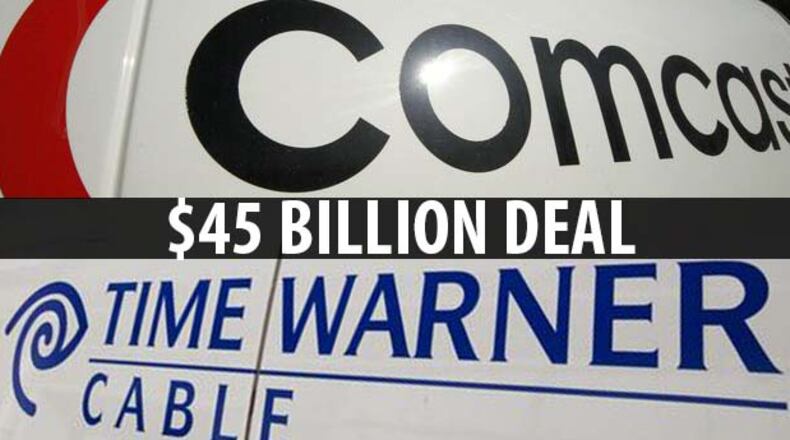Who’s the biggest?
The top providers of pay TV by number of U.S. subscribers:
COMCAST:
Video customers: 21.69 million
(Internet customers: 20.66 million)
DIRECTV:
Video customers: 20.16 million
(Internet customers: None)
DISH NETWORK:
Video customers: 14.05 million
(Internet customers: 385,000)
TIME WARNER CABLE:
Video customers: 11.39 million
(Internet customers: 11.61 million)
AT&T:
Video customers: 5.46 million
(Internet customers: 16.43 million)
VERIZON:
Video customers: 5.26 million
(Internet customers: 6.07 million)
COX:
Video customers: Estimated 4.5 million
(Internet customers: Estimated 4.5 million)
CHARTER:
Video customers: 4.18 million
(Internet customers: 4.29 million)
CABLEVISION:
Video customers: 2.83 million
(Internet customers: 2.77 million)
Sources: Company quarterly earnings reports, Leichtman Research Group estimates.
What the deal means
• Comcast is the biggest cable TV and internet provider in the United States. The company packages its “triple play” cable, TV and phone service under the Xfinity brand name.
• Comcast has 22 million pay TV subscribers and will add Time Warner Cable’s 11.2 million.
• Time Warner customers could get a new set-top box. Comcast has invested in a next generation internet-enabled cable box called X1, which it says offers a better experience for watching video on demand and browsing channels.
• Comcast has markets in Cleveland and Youngstown. It will add Cincinnati, Cleveland, Columbus, Dayton, Lima, Toledo and Zanesville from Time Warner.
• Some of the company’s best-known networks include NBC, Bravo Media, Comcast Sportsnet, Golf Channel, Sprout, Universal HD, E!, MSNBC, Syfy, USA Network, The Weather Channel Cos., CNBC and Oxygen Media.
Comcast will gain a stronghold of Ohio customers as part of a proposed $45.2 billion deal to acquire Time Warner Cable. The agreement to combine the nation’s two largest cable television providers, approved Thursday by the boards of both companies, would create a dominant force in U.S. pay TV and broadband Internet, with more than 30 million customers nationwide.
The all-stock deal, which would put Comcast in 19 of the country’s 20 largest TV markets and all of Ohio’s large markets, is expected to close by the end of 2014, pending shareholder and regulatory approvals.
The merger will end up costing the public more money over time, according to Dennis Greene, a University of Dayton professor of law. “At the end of the day, consumers have less options for other types of ways to get their television,” he said.
Brian L. Roberts, Comcast’s chairman and chief executive, said the transaction is “strongly in the public interest and, we believe, approvable.” Comcast and Time Warner Cable don’t serve overlapping markets, “so there is no reduction in competition” for consumers, he said in a media teleconference.
Roberts said the merger positions the combined companies to better compete with a new landscape of pay TV and broadband providers that include Dish Network, DirecTV, AT&T and Verizon.
Time Warner Cable customers will benefit from Comcast’s cloud-based interactive television system, higher broadband speeds and faster home Wi-Fi networks, officials said.
Comcast will detail any changes to customer pricing, technology and service in its public filings during the regulatory review process, Roberts said. Officials said the deal will generate about $1.5 billion in operating efficiencies for the combined companies.
Time Warner Cable employs 1,900 workers in southwest Ohio, said Michael Pedelty, the company’s Midwest spokesman.
Michael Angelakis, Comcast’s vice chairman and chief financial officer, declined to discuss possible job cuts that could result from the merger.
“There are a lot of duplicative areas, obviously, when you have two large public companies,” Angelakis said. “But overall it is just a variety of different things that are making up that savings. A minority of those numbers are on the programming savings side.”
Comcast will acquire Time Warner Cable’s 11.2 million customers, located mainly in five geographic areas: New York; North and South Carolina; Ohio, Kentucky and Wisconsin; Southern California; and Texas.
Time Warner Cable is Ohio’s top pay TV provider, with large customer areas in Cleveland, Akron, Columbus, Cincinnati and Dayton.
Comcast, which also owns NBCUniversal, has 22 million pay TV customers, but plans to divest 3 million subscribers as part of the transaction.
The combined companies’ total of about 30 million customers would keep Comcast’s share of the U.S. pay TV market below 30 percent, which will reduce antitrust concerns, officials said.
Greene said the merger is an “economically efficient” way for Comcast to expand into new markets. “They can basically move into the market and control the cable, as opposed to having to move into the market and compete with another cable company,” he said.
Many consumers are dependent on corporate TV providers, because most television is no longer available free over the public airwaves, Greene said.
Last year, Time Warner Cable lost more than 300,000 customers over a three-month period, in part because of a month-long blackout of CBS in New York City, Los Angeles, Dallas and other markets during a dispute over retransmission fees.
“At the end of the day we negotiate hard, but we’re all most interested in delivering value to our customers without disruption, and I’m sure that is what Comcast will continue to do,” said Robert D. Marcus, Time Warner Cable’s chairman and chief executive.
Roberts said every cable operator has lost TV customers over the last 10 years because of increased competition from DirecTV, Dish Network, AT&T, Verizon “and, in many cases, a fifth provider.” In contrast, Comcast added subscribers in the fourth quarter of 2013 for the first time since 2007, he said.
He attributed that growth to the company’s media and technology offerings for consumers and businesses.
Roberts said Time Warner Cable customers can expect more competitive choices for products, increasingly faster Internet speeds, and experiences such interacting with their television with a tablet or smartphone. “We are going to invest and create jobs, as we have for over 50 years,” he said.
About the Author
